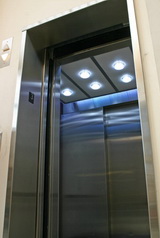In Home Elevators
Some of the newer homes being built have the added luxury of in home elevators. However, for older constructions, the type of in home elevators would be more limited based on size and the available locations where an elevator could be installed. One thing to keep in mind is that some types of elevators require a 'pit' below the building which would make them next to impossible to install in an existing structure. Some common types of in home elevators are stairway elevators for handicapped persons, vacuum elevators and electric room-less electric elevators which don't require a pit.
Adding In Home Elevators to Existing Structures
There are three things to consider when adding in home elevators to existing structures. The first thing would be size. Many homes just don't have ample amounts of room to accommodate anything larger than a 4' x 6' elevator which would make your choices a bit limited. The next thing to consider would be function. Does the elevator need to accommodate a handicapped person with special needs in terms of size and operation of the machinery? Finally, cost might be an issue. If your funds are limited then you will most likely need the simplest type of in home elevator that can safely transport individuals up and down levels of the home and aesthetic appeal might be lacking.
Greater Flexibility in New Constructions
Of course your options are a whole lot less limited when planning in home elevators into the architectural designs when having a home built. You can choose from pneumatic vacuum elevators, traditional hydraulic elevators, cable elevators and even stairway elevators if needed. Most often hydraulic elevators require a pit being dug under the area where the elevator will be located because of the jackscrew that will push the elevator up as it ascends the different levels. Pneumatic vacuum elevators, on the other hand, are often fashioned from glass and are operated solely on air pressure. Stairway elevators are simply a chair that moves up and down the stairway and they can be made to go straight up, or to curve around if the stairway is winding. This type of elevator is ideal for elderly family members who have trouble safely getting up and down the stairs.
Whether in home elevators are required to assist disabled person in getting up and down levels within the home or are merely a convenience, one thing is for certain. In home elevators can greatly add to the market value of the home. Some estimates say that the addition of an elevator increases the value by as much as 10%, if not more! If price is not an issue, there are some extremely lovely elevators on the market that will actually enhance the look of your home, while others are not as visually pleasing but have greater functionality. Before choosing the manufacturer and/or installer of in home elevators, it would be a good idea to do a little comparison shopping. One model might be more visually attractive but cost 4 to 5 times more than a model that is merely functional. By comparing quotes you can find the elevator that best suits your needs as well as your budget.

